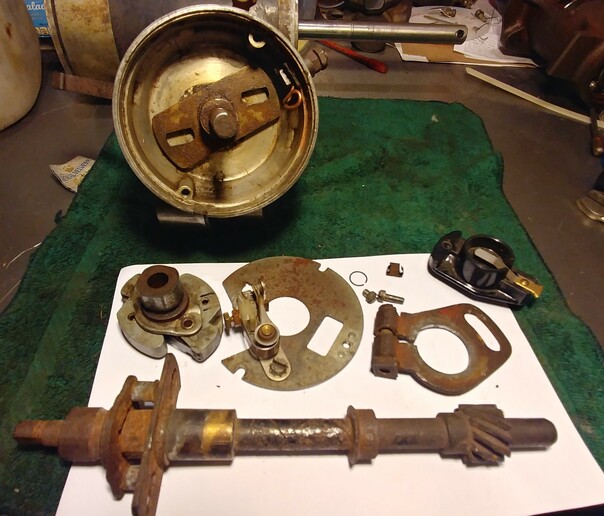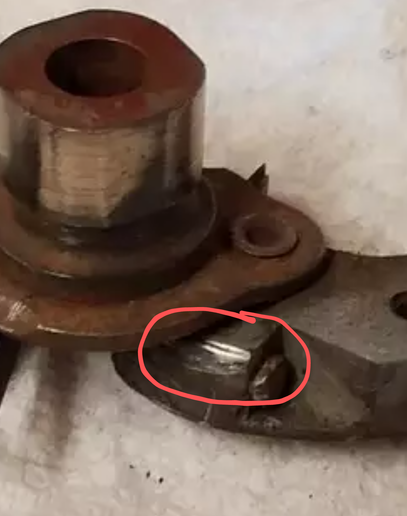DistributorsHateMe
Member
Hi All,
Last week, my husband went out to start our 1952 Ford 8N with sidemount distributor. Hadn't been run in about a month. Wouldn't start. After fiddling with the distributor for a few minutes, he said we needed new points and condenser. He had me pick them up at the tractor dealership. Then, in the process of changing them out, he dropped a screw into the hole in the distributor plate.
It's my understanding that some distributor plates can be removed. Evidently, this particular one is not that type, and we couldn't see the loose screw to get it out of the hole. Foolishly, we tried to start the tractor anyway. Bad idea. The entire distributor housing, which was firmly bolted in place, pivoted 180 degrees.
I started looking online for what to do.
First, I loosened the nut that holds the distributor housing in place. Turned the housing until the loose screw rolled into view through the hole in the plate. Removed the screw. Rotated the housing so that it was more or less in its original position and tightened the nut. Put the the distributor cap back on. Wouldn't start--just backfired a couple of times.
After reading some more online forum posts, I opened the little "window" so I could see the flywheel and turned it with a screwdriver until I could see the timing marks on the flywheel. Set that to 4 degrees. Also re-loosened the nut so I could turn the distributor housing (again) so that the rotor position would roughly correspond to the position of the first spark plug wire on the distributor cap. Put the cap on. Tried to start it. It fired briefly. Tried once more to start it, and the whole distributor housing turned 180 degrees again. Ugh!
What in the world is going on?!? I noticed some powdery dust/dirt has accumulated under the plate. Is that all it takes to bring a tractor to its knees? I can't clean it properly or check the condition of the weights with the plate in the way. That means I will have to pull the distributor, right? And even if I do that, how would I check the condition of the weights, or replace them if necessary if the plate's in the way?
I read on another forum where somebody with similar issues pulled their distributor and found that the roll pin on the distributor shaft had sheared. Not sure what that means, but maybe that's our problem?
I'm starting to think the thing is such a mess now, I don't have much to lose by pulling the distributor myself to look for obvious problems and to remove the additional debris under the (fixed) plate.
Thing is, this procedure would be uncharted territory for me. And my husband, who is pushing 70 years old and is not well, has always despised working on the tractor. He wants me to just call somebody to come out and fix it.
Three years ago, we had a guy come out to fix the distributor. It took him 20 minutes. He charged $240, wrecked our satellite dish with his side mirror (and lied about it), and, as he was leaving, grazed half the bark off of a redbud tree that has since died. Still, he fixed the tractor well enough that it's been running fine ever since--until now.
Being too intimidated to even [i:792ec557fc]try[/i:792ec557fc] to fix it myself is a poor reason to shell out hundreds of dollars to somebody else to do it. It's not an engine rebuild--it's only a distributor, right? In past years, I've replaced the carb, the spark plugs and plug wires, and the sediment bowl. Obviously, pulling the distributor is a more complex operation.
I'm wondering if someone here can walk me through the process of removing, troubleshooting, and reinstalling the distributor--and then help me get the thing timed correctly. If not--or if I can't follow the instructions y'all give me--I can still always resort to calling someone to fix it.
What do you think, folks? Are you game? Should I give it a shot, or am I biting off more than I can chew?
Last week, my husband went out to start our 1952 Ford 8N with sidemount distributor. Hadn't been run in about a month. Wouldn't start. After fiddling with the distributor for a few minutes, he said we needed new points and condenser. He had me pick them up at the tractor dealership. Then, in the process of changing them out, he dropped a screw into the hole in the distributor plate.
It's my understanding that some distributor plates can be removed. Evidently, this particular one is not that type, and we couldn't see the loose screw to get it out of the hole. Foolishly, we tried to start the tractor anyway. Bad idea. The entire distributor housing, which was firmly bolted in place, pivoted 180 degrees.
I started looking online for what to do.
First, I loosened the nut that holds the distributor housing in place. Turned the housing until the loose screw rolled into view through the hole in the plate. Removed the screw. Rotated the housing so that it was more or less in its original position and tightened the nut. Put the the distributor cap back on. Wouldn't start--just backfired a couple of times.
After reading some more online forum posts, I opened the little "window" so I could see the flywheel and turned it with a screwdriver until I could see the timing marks on the flywheel. Set that to 4 degrees. Also re-loosened the nut so I could turn the distributor housing (again) so that the rotor position would roughly correspond to the position of the first spark plug wire on the distributor cap. Put the cap on. Tried to start it. It fired briefly. Tried once more to start it, and the whole distributor housing turned 180 degrees again. Ugh!
What in the world is going on?!? I noticed some powdery dust/dirt has accumulated under the plate. Is that all it takes to bring a tractor to its knees? I can't clean it properly or check the condition of the weights with the plate in the way. That means I will have to pull the distributor, right? And even if I do that, how would I check the condition of the weights, or replace them if necessary if the plate's in the way?
I read on another forum where somebody with similar issues pulled their distributor and found that the roll pin on the distributor shaft had sheared. Not sure what that means, but maybe that's our problem?
I'm starting to think the thing is such a mess now, I don't have much to lose by pulling the distributor myself to look for obvious problems and to remove the additional debris under the (fixed) plate.
Thing is, this procedure would be uncharted territory for me. And my husband, who is pushing 70 years old and is not well, has always despised working on the tractor. He wants me to just call somebody to come out and fix it.
Three years ago, we had a guy come out to fix the distributor. It took him 20 minutes. He charged $240, wrecked our satellite dish with his side mirror (and lied about it), and, as he was leaving, grazed half the bark off of a redbud tree that has since died. Still, he fixed the tractor well enough that it's been running fine ever since--until now.
Being too intimidated to even [i:792ec557fc]try[/i:792ec557fc] to fix it myself is a poor reason to shell out hundreds of dollars to somebody else to do it. It's not an engine rebuild--it's only a distributor, right? In past years, I've replaced the carb, the spark plugs and plug wires, and the sediment bowl. Obviously, pulling the distributor is a more complex operation.
I'm wondering if someone here can walk me through the process of removing, troubleshooting, and reinstalling the distributor--and then help me get the thing timed correctly. If not--or if I can't follow the instructions y'all give me--I can still always resort to calling someone to fix it.
What do you think, folks? Are you game? Should I give it a shot, or am I biting off more than I can chew?















